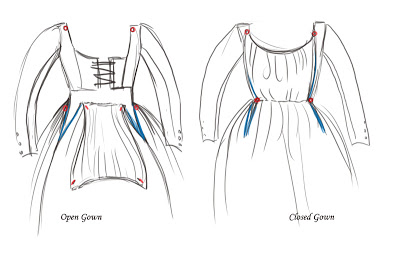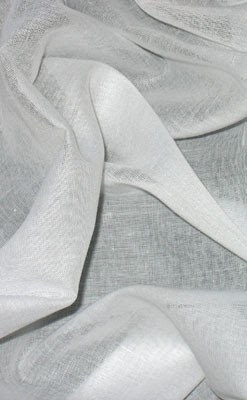
Welcome back to Costume Analytics. This week we’ll be looking at a beautiful example of a 1795 transitional garment known as a “gaulle,” painted by Jacques Louis David, worn by Emilie Seriziat. The gaulle is an interesting garment because it takes its cues from the Chemise a la Reine, a flowy “peasant” gown popularized by Marie Antoinette. Where the gaulle differs, though, is that it is fitted through the back, often has fitted, shaped sleeves, but retains the gathers in the front, and the full skirt. This garment set the stage for the ubiquitous bib-front or drop-front gown we know from the Regency. Let’s take a look:

Pattern
The gaulle appears to be a simple garment, but it has its fair share of engineering. At first we see a gathered front, but fitted shoulders, fitted two-piece sleeves, and a full skirt. However, the gathered front is a “false” front, and beneath it is an under-bodice that laces (most likely) tightly closed across the front of Emilie’s stays. The gathered front of the bodice is attached at the waist, and when pulled up over the front of the chest, is secured to the shoulder straps, either with pins, hooks, or buttons.

The skirt appears to open at the sides, typical of 18th c. petticoats. This would allow Emilie to get into the gown in the first place, but also wear pockets. The mysterious part is the waist seam. Examples of gaulles we find in films and museum often don’t have a waist seam, and just cinch with the sash, so I suspect that this waist seam is false, and that the gown opens below the waist, then likely is secured at the waist with pins, hooks, or buttons, and again at the shoulders.

This kind of trickery can be seen in extant Regency garments:
 |
| From”Vintage Textiles” website |
 |
| From “Vintage Textiles” website. |
We also see it used for two film costumes, from “The Duchess” and “Marie Antoinette.”
 |
| The Duchess de Polignac, “Marie Antoinette |
 |
| From “The Duchess,” |
 |
| A good example from “The Duchess, fitted back of the gown |
And for an in-depth look at how these gowns closed, take a gander at the gaulles made by Sarah of Mode Historique, and Jenny La Fleur’s Summer Gaulle project.
* One more little mystery – what is going on up near the shoulder? There appears to be a standing collar that drapes down over the back of Emilie’s shoulder. Could the drop-front possibly have tied around the back of the bodice, covered by some sort of shawl collar thing? It’s a design we don’t commonly see on this kind of garment, but I wouldn’t put it past those crazy Marveilleuses!
Fabric & Trims

This sort of gown was popular in muslin as well as silk. Emilie’s version appears to be a thin muslin, and would be very tightly gathered at the front, and through the skirt, for maximum fullness. The gown would have been lined, probably in linen, and this lining separate at the front, where the placket laces. A cotton voile or batiste would be perfect for this gown – just get A LOT of it.
Emilie’s sash appears to be a pine green silk, possibly a taffeta, tied at the front. This matches the ribbons on her bonnet, as well. The only other decoration we see on the gown are the three self-covered buttons at the cuffs of the sleeves. Other than that, the gaulle was never supposed to be an extravagant garment, but instead a reflection of classical ideals, simplicity, pastoralness, a departure from the rococo sensibilities we see earlier in the century, or even just ten years before.
Accessories

Emilie wears a “statement bonnet,” covered in large ribbons on both sides, and worn over a lacy mob cap. It’s an interesting juxtaposition given the simplicity of her gown. The bonnet is off a style we begin to see more of later, in the Regency – it’s straw, and a very open shape, with a deep crown. It’s tied loosely under her chin with a blue silk ribbon (interestingly enough this ribbon doesn’t match the green, so perhaps she re-trimmed the hat to match her sash that day?). For her hairstyle, Emilie wears a somewhat subdued hedgehog style with long tendrils hanging loose down her back. This may very well have been her real hair, or at least some of it.
Emilie also wears a fichu tucked into the front of her gown. This would have been a lightweight fabric – muslin, batiste, cotton voile.
 |
| Transitional Stay, 1790s. |
Underpinnings – Emilie would have been wearing stays. They might have been full-length, or they might have been transitional stays. She also would have been wearing a chemise under her stays, and layers and layers of petticoats over them, to puff out her skirts. Her shoes would have been slippers with a very low “kitten” heel (we call it), and a pointed toe.
 |
| From the Met, 1780-99 |
Tips on Making This Costume
 |
| Janet Arnold, Patterns of Fashion 1 |
- Unfortunately the gaulle is not a common pattern. Try Fig Leaf’s 1795 “work dress” pattern, or if you like the look, but are uncomfortable working off-pattern, try a Chemise a la Reine
from Patterns of Time.
- Try altering a bib-front Regency gown by lowering the waistline to the natural waist. This will take some fitting and fiddling. Try the Lewis & Clark Empire gown, or Janet Arnold’s drop-front pattern from Patterns of Fashion 1
, pg 48.
- Go for voile or batiste cotton – it’s cheap, it’s pretty. I recommend Dharma Trading Company. They carry fantastic cotton voile as well as silk voile. Get lots.
- For the bonnet, get crafty with a basic straw hat from your local craft store, or try a straw bonnet or large-brimmed hat from Top-Hats.com. Dress in ribbons matching your sash. Explore other hat styles of this period – there were many!




12 Comments
Abigael
December 13, 2010 at 9:15 PMThank you so much for this post! I have loved this painting for a long time but never noticed the buttoning front… The collar, to me, looks almost like a completely separate piece, tucked inside the neckline of the dress. Almost like a weird, back-only chemisette. I've never seen anything like it on anything else…
Abby
December 14, 2010 at 11:04 AMThere are also examples that do not have the false inner-bodice, but tie in 3-ish different places across the bodice section to create the gathered look and they also have the quartered back. The Burrell collections in Glasgow Scotland have a pretty one that's of a tiny multi floral print cotton.
Great Post! 😀
Lauren Stowell
December 14, 2010 at 10:20 PMAbigael – oo, hadn't thought of the tuck-in collar. Could be! I've never seen anything like it either, but I'm so intrigued.
Abby – I'll have to look up that Scottish dress. The Chemise a la Reine and the Gaulle trouble me…they look so simple but are really quite complex. And then there's that whole desire to make one, especially after looking closely at this painting. Argh! Another thing to add to le list.
Angela
December 15, 2010 at 6:38 PMHello. It has been a long time since I have visited. Life has happened. However, I love the new look of your site. Wow! Lovely. I am really enjoying the Analytics. Really helps to look at these garments that we have looked at for years through another lens. I made a gualle once and did have a waist seam as I constructed the front so that it was permanently gathered onto a foundation and hooked and eyed up the front invisibly. The trick was closing the skirt which was not attached to the bodice front. So, it was get in, close the skirt at the waist to the side (side opening) then close the front bodice and (dare I say it), snap it to the front waistband and sash over it. Not very period but it worked.
Thanks for sharing and I hope to visit more often.
Lauren Stowell
December 15, 2010 at 8:28 PMHi Angela. Welcome back! Your method of getting into and closing your gaulle sounds perfectly acceptable to me. I'm not a hard-core when it comes to these sorts of hidden things, I think snaps are a great idea, and act as a modern replacement for pins, which we all know have the ability to a) fall out, and b) poke you.
Now I have to make a gaulle, hahaha.
MrsC (Maryanne)
December 16, 2010 at 8:26 PMThe two dresses from movies definitely have waist seams as their skirts have WAY more gathered fabric in them than the bodice allows for. Very pretty, we don't see enough of these trasnitional looks 🙂 Go on, make one, you know you want to!
Abby
December 16, 2010 at 9:12 PMLauren, I think I have pictures of the dress. Let me nose around on my computer and I'll see if I have any to pass on to you. 🙂
Sandi
August 2, 2011 at 12:12 AMGualle…I will have to make a note of that, as this is fascinating, and comes under the 'learning something new every day' heading.
Thanks for another brilliant and informative blog, Lauren…I, too, thought that this was just a simple drawstring dress, but see that it still retains the 18th century complications of construction that make the transitional styles so fascinating.
This blog entry was stumbled upon due to me clicking on a link in the previos blog that I was reading…now I have forgotten what that was. (Note to self, finish reading before clicking on links!!)
Hana - Marmota
May 19, 2013 at 5:04 PMI think since you posted this, this pattern came out:
http://sensibility.com/blog/patterns/ladies-1780s-portrait-dress-pattern/
I have not worked with it, but it looks like it could be adapted into this style.
Also, the more I look at the portrait, the more I think the "weird standing collar thing" is just a combination of the crisp tuck-in fichu and a white ribbon hanging down from the hat.
Hana - Marmota
May 19, 2013 at 5:05 PMP.S. Or maybe the ribbon ties her hair.
WendyM
June 16, 2015 at 7:10 PMI have used the Sense & Sensibility Pattern – it works up easily and quickly. One warning is to use a very fine light weight fabric. A midweight linen (the only thing I had in a pinch) works up to be very bulky.
sam b
January 27, 2018 at 6:21 PMAbout the mystery-fabric behind her neck: in the close-ups it looks like it drapes from the back of her cap; since some caps could be huge with long lappets, it's not impossible.